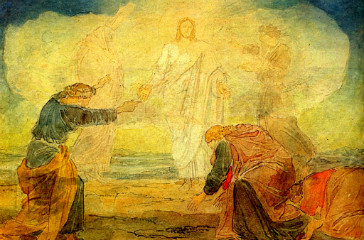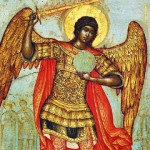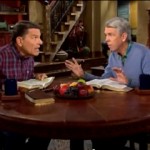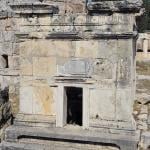
Jesus had at times a large entourage, but he revealed certain things to small and select group of disciples. Matthew, Mark, and Luke all tell about the time that Jesus took Peter, James, and the young John to pray on the mountain, traditionally Mount Tabor. While there, as the evangelists describe it, Jesus was majestically transfigured before their eyes.
Here’s how Mark described what happened: “[H]is garments became glistening, intensely white, as no fuller on earth could bleach them.” But the effect was more than external. “[H]is face shone like the sun,” said Matthew.
Divinity on display
The disciples were overwhelmed and overcome by the blazing light. Icons of the moment usually show the three falling back and covering their eyes from the glare. Totally stunned, Peter famously started mouthing inanities.
Interestingly, unlike Matthew, Mark, and Luke — the evangelists who record the event — John actually saw the Transfiguration in person. But he never wrote about it, at least not directly. Instead, he spoke of Jesus as “the life [that] was the light of men.”
While the other evangelists report events for theological purposes, the gospel of John is primarily a theological reflection from someone who beheld the “glory” of “the only Son from the Father” in person.
When God laid down his life
In celebrating the Feast of the Transfiguration, the Orthodox church sings this hymn:
You were transfigured on the mount,
And your disciples, insofar as they were able,
Beheld your glory, O Christ our God:
So that when they should see you crucified,
They would remember that your suffering was voluntary,
And could declare to all the world
That you are truly the effulgent splendor of the Father.
Note that line: “your suffering was voluntary.” In his book The Mystery of Christ, John Behr points out that theology begins when we can look past the bare events of the crucifixion to reflect upon its voluntary nature. Jesus gave himself up for our sakes. The Transfiguration helped the disciples see that.
John Chrysostom alludes to this when commenting on the event. The transfiguration worked “[t]o show the glory of the cross, and to console Peter and the others in their dread of the passion, and to raise up their minds,” he said.
When later reflecting on the crucifixion, the disciples would now do so in the context of the vision they’d seen of Christ in his divinity. The Transfiguration made it clear that God in Christ laid down his life, and that willingly.
The power of life and death
The light of Tabor helped sear that truth into the mind of the early church. The letter of Hebrews, for instance, speaks of Christ offering himself up for us. The letter to the Philippians speaks of his willing obedience unto death. The gospels give us various scenes and passages that communicate the same thought, perhaps none more powerfully than in the tenth chapter of John’s gospel.
“For this reason the Father loves me,” John quotes Jesus saying, “because I lay down my life, that I may take it again. No one takes it from me, but I lay it down of my own accord. I have power to lay it down, and I have power to take it again. . . .”
Christ had the power of life and death because Christ was evidently, glaringly, palpably divine — something John experienced first hand at the Transfiguration.
Appreciation
The church celebrated this from the start. For instance, one of its earliest liturgies, The Liturgy of Saint James, speaks of Jesus “being about to endure His voluntary and life-giving death by the cross. . . .” Immediately following that it references “the night in which He was betrayed, nay, rather delivered Himself up for the life and salvation of the world. . . .”
Catch that? The text comments on Christ’s betrayal to add that he “delivered Himself up.”
Theology is about more than understanding in the intellectual sense of the word. It’s about appreciation. The Transfiguration, as Chrysostom said, elevates our minds to the glory of a God who would lay down his life to raise up ours.












